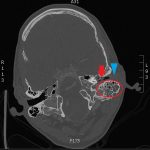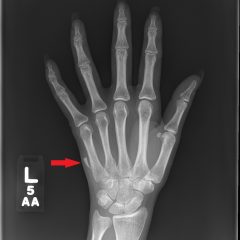A Case of Otomastoiditis
History of present illness:
A 45-year-old male presented to the emergency department with chief complaint of left ear pain with yellow discharge for several days. He had associated decrease in appetite. The patient denied any history of fever, headache, dizziness, hearing loss, or tinnitus. On physical exam, the patient was found to have yellow discharge in the left ear canal with a perforated tympanic membrane. He was also found to have significant tenderness to palpation over the left mastoid bone.
Significant findings:
The patient underwent computed tomography (CT) of the head which revealed opacification of the left middle ear (red arrow) and mastoid air cells (red circles). Additionally, there was thickening of the soft tissues of the external auditory canal (blue arrowhead), likely reflecting concurrent otitis externa. Based on the imaging, he was admitted for findings consistent with acute otomastoiditis.
Discussion:
Mastoiditis is an infection of the mastoid air cells of the temporal bone often secondary to undertreated or untreated otitis media. On CT, purulent material and mucosal swelling cause opacification of the air cells, as seen in this patient.1 The inflammation can erode into the mastoid septae causing acute coalescent otomastoiditis. Mastoiditis can invade intracranially leading to sigmoid sinus thrombosis, perisinus empyema, epidural abscess, subdural abscess or meningitis.1
Presentation of mastoiditis includes fever, otalgia and otorrhea. Patients may also have erythema and swelling overlying the mastoid process.2 Most patients presenting with acute mastoiditis will require hospital admission for intravenous (IV) antibiotics. Antibiotics should cover the common causative agents of otitis media including H influenzae, M catarrhalis, S pneumoniae as well as S aureus. Mastoidectomy is reserved for cases where medical management fails.3
In the antibiotic era, the incidence of clinically significant acute mastoiditis has decreased to 1.2-2 per 100,000.2 However, it is important to recognize that acute mastoiditis may present with severe intracranial complications resulting in significant morbidity and mortality.3 Therefore, patients with suspected mastoiditis should receive a thorough physical examand cranial imaging studies to evaluate for bone erosion and other sequelae.4
The patient in this case remained afebrile without leukocytosis throughout hospitalization. A final blood culture yielded gram positive cocci, gram negative cocci, gram positive rods and methicillin resistant staph aureus with Clindamycin susceptibility. The otolaryngologist (ENT) started the patient on IV ceftriaxone and IV clindamycin for 72 hours. He was discharged with ENT follow-up on an oral regimen of clindamycin and cefuroxime for two weeks. He was also administered ofloxacin otic solution throughout his hospitalization and at discharge.
Topics:
Mastoiditis, otomastoiditis, otitis externa, CT
References:
- Patel KM, Almutairi A, Mafee MF. Acute otomastoiditis and its complications: role of imaging. Operative Techniques in Otolaryngology. 2014;25(1):21-28. doi: 10.1016/j.otot.2013.11.004
- Rubin MA, Ford LC, Gonzales R. Sore throat, earache, and upper respiratory symptoms. In: Kasper DL, Hauser SL, Jameson JL, Fauci AS, Longo DL, and Loscalzo J, eds. Harrison’s Principles of Internal Medicine. 19th ed. New York, NY: McGraw-Hill; 2014:247-254.
- Jauch EC, White DR, Knoop KJ. Ear, nose, and throat conditions. In: Knoop KJ, Stack LB, Storrow AB, and Thurman RJ, eds. The Atlas of Emergency Medicine. 4th ed. New York, NY: McGraw-Hill; 2016:99-134.
- Luntz M, Bartal K, Brodsky A, Shihada R. Acute mastoiditis: the role of imaging for identifying intracranial complications. The Laryngoscope. 2012;122(12):2813-2817. doi: 10.1002/lary.22193






